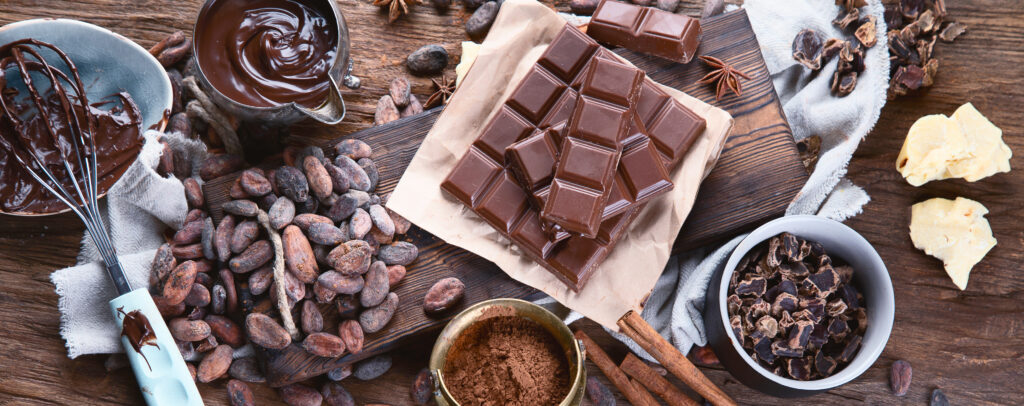
Philadelphia has long held a place in the history of the United States as one of the cornerstones of our Nation’s birth. It was the first Capital city and the place where the words of the Declaration of Independence and the Constitution were first heard emanating from Independence Hall. But did you know that it was also the hub of all things chocolate in Colonial and Post-Colonial America?
The Early History of Chocolate in the Colonies
The domestic manufacture and consumption of chocolate were widespread throughout the young colonies. In fact, drinking hot chocolate in the morning was considered to be an excellent restorative in 18th-century America, although it was also enjoyed throughout the day.
In 1767, the Townsend Acts imposed a tax on tea, which eventually led to the Boston Tea Party and the Revolution. During this time, drinking chocolate instead of tea became a patriotic act! Many of the Nation’s Founding Fathers were avid consumers of chocolate, including Washington, John Adams, and Thomas Jefferson.
In Virginia, George and Martha Washington were known to have ordered up to 50 pounds of chocolate at a time, and inventories at Mount Vernon record a set of chocolate cups and saucers as part of a gold and white French china service acquired by the couple in 1790.
Chocolate in Philadelphia
Pennsylvania’s relationship with chocolate began early in the colonial days. In fact, in the early Colonial days, a major proponent of chocolate in Philadelphia was Benjamin Franklin, who started selling chocolate from his print shop as early as 1739. In 1757 Benjamin Jackson was selling some of the earliest handmade bars of chocolate in Philadelphia at Second and Market streets. In fact, Benjamin Rush, a well-known Philadelphia physician, avidly promoted chocolate for medical use.
However, the sweet, creamy chocolate we know today was very different in colonial times. The chocolate enjoyed by our forefathers came in the form of small grainy cakes. When preparing hot chocolate, the chocolate was grated from the cakes and then whipped with hot water to produce a frothy, thick, smooth drink, much the same way the native Olmec culture prepared it four thousand years ago in Mesoamerica!
Early Colonial chocolate in Philadelphia and throughout the fledgling country was dark, slightly bitter chocolate with about 63% cacao content. Sugar was an expensive luxury in early America, so this dark chocolate was mixed with an array of spices like cinnamon, orange, anise, nutmeg, chili pepper, and vanilla.
It wasn’t until after the revolution that chocolate in Philadelphia became the dominant confection thanks to the city’s role in the sugar trade.
The Growth of an Early American Industry
Post-colonial America was struggling to grow, and Philadelphia was a thriving port city in our young, newly independent country. Two of the predominant commodities that came into the port of Philadelphia were sugar and cocoa beans. In fact, even today, nearly 80% of all of the cocoa beans imported into the United States come through the Port of Philadelphia!
By the early 19th century, cocoa was a significant import in American. Chocolate in Philadelphia and throughout the country was being enjoyed by people of all classes. Because of its role in the sugar and cocoa bean trade, chocolate in Philadelphia was thriving!
As the Industrial Revolution took hold in the early 19th century, mechanized sugar refineries were built along the Delaware River, and the now affordable, and readily available refined sugar created opportunities for confections entrepreneurs. Thanks to its proximity to ready supplies of cocoa beans and sugar, chocolate in Philadelphia thrived as the city became a hub for confectioners with many soon to be famous companies setting up shop in the city!
By the mid-1800s, chocolate in Philadelphia was a thriving industry. Big names in the Philadelphia chocolate industry included Quaker City Chocolate, Wilbur, Laurent and Maron, and Whitman’s. All of these companies were producing “cream chocolates. The early 1800s found the fledgling candy-making industry in Philadelphia featured 20 small shops that by the early 1900s had exploded to more than 130 companies with combined sales of over $7 million – equivalent to $175 million today!
Then and Now!
During its industrial heyday in the 19th and early 20th centuries, Philadelphia dominated the chocolate industry with companies like Whitman’s Samplers, and Wilbur Buds turning out delectable treats.
Fortunately, today chocolate in Philadelphia is experiencing a renaissance, and the industry is going strong. With a nod to the “old school,” more than a dozen boutique makers are turning out delicious chocolate in Philadelphia, including gourmet chocolate bonbons, bars, truffles, and buttercreams.